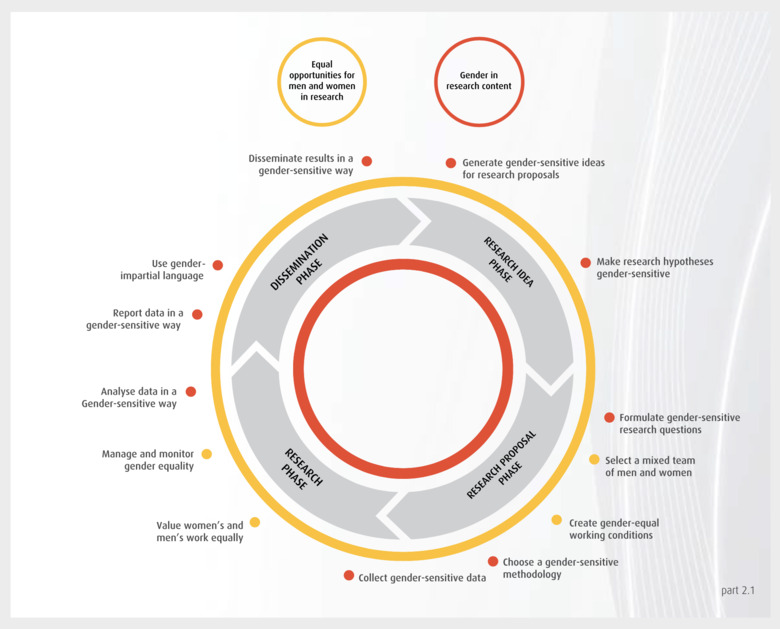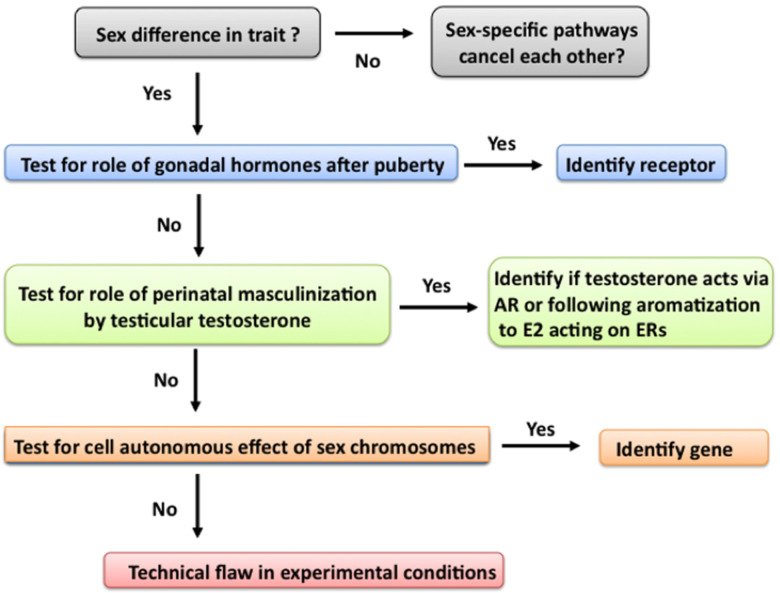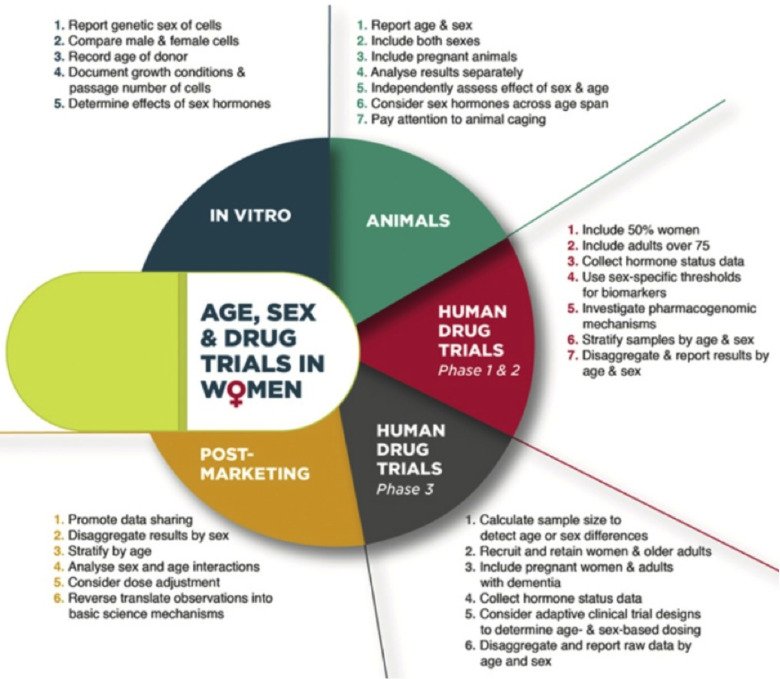Resources portfolio - Gendered Innovation Alliance
Welcome to the toolbox for the implementation of sex, gender & diversity dimension aspects in biomedical research and education.
The following resources are continuously developed by the Gendered Innovation Alliance in order to add significant value to innovation. Please let us know if you have any comments or suggestions.
| Term | Explanation |
|---|---|
| Diversity | the inclusion of different types of people (with multicultural backgrounds) and/or all minority groups. In simple terms, diversity means difference and has no negative connotations. There is diversity in the health care workforce and the patient populations we serve. Human diversity that needs to be recognized and understood to prevent these differences from becoming barriers. |
| Gender | a socio-cultural process – refers to cultural and social attitudes that together shape and sanction “feminine” and “masculine” behaviours, products, technologies, environments, and knowledge. Gender equality: gender equality is the result of the absence of discrimination on the basis of a person’s sex in opportunities and the allocation of resources or benefits or in access to services. |
| Gender dimension in research | is a concept regrouping the various elements concerning biological characteristics and social/cultural factors of both women and men into the development of research policies, programmes and projects. |
| Intersectionality | relates to the observation that power structures based on categories such as gender, race, sexuality, functionality and class interact with each other in various ways and create inequalities, discrimination and oppression. |
| Sex | refers to biological qualities characteristic of women [females] and men [males] in terms of reproductive organs and functions based on chromosomal complement and physiology. As such, sex is globally understood as the classification of living things as male and female, and intersexed. |
| Sex/ gender analysis | is an umbrella term for the entire research cycle that includes the integration of sex/ gender issues from the setting of research priorities through developing methodologies, gathering and analysing data to evaluating and reporting results and transferring them to markets. |
Integrating Sex & Gender in Health Research
There is growing recognition that the quality and generalisability of biomedical research depends on the consideration of key biological variables, such as sex. For a brief introduction, the first video from ACTonGender might be helpful. If you have more time (1h), the second video: Sex and gender dimension in research: Health & Medicine, from Gender Equality Academy EU is more extensive.
In 2018, the Swedish Research Council received a new task in their directive from the Government: to ensure that a sex and gender perspective is included, when applicable, in the research funded by them - Are sex and gender perspectives relevant in your research?
The following key paragraphs from the NIH policy - on Sex as a Biological Variable, are also significant:
Accounting for sex as a biological variable begins with the development of research questions and study design. It also includes data collection and analysis of results, as well as reporting of findings. Consideration of sex may be critical to the interpretation, validation, and generalizability of research findings.
Adequate consideration of both sexes in experiments and disaggregation of data by sex allows for sex-based comparisons and may inform clinical interventions. Appropriate analysis and transparent reporting of data by sex may therefore enhance the rigor and applicability of preclinical biomedical research.
How to make research gender sensitive - twin approach
Gender-sensitive research takes a twin approach: it pays attention to the participation of women and men, providing equal opportunities for all, and it integrates gender into the research content all the way from the initial research idea to the dissemination of results. You can read more in the publication: Toolkit Gender in EU-funded research.
In practice, to make research gender-sensitive, one needs to take gender into account at all stages of the research cycle:

Funder's requirements
- Integrating sex and gender into your research (proposal) KI Grants Office provide information on funders’ requirements relating to the sex-and-gender dimension, as well as resources to help you address it.
- Think about sex – if you want to win that grant is a helpful summary.
Education & Courses
Online Tools & Guidelines
- Sex and Gender in Health and Disease from the NIH Office of Research on Women's Health
- Meet the Methods series from Canadian Institutes of Health Research
- How to integrate sex and gender into research from Canadian Institutes of Health Research
- Distinguish between and define sex and gender in health research;
- Identify sex and gender differences in the mechanism, disease or treatment under study;
- Identify methods for integrating sex and gender variables in health research contexts; and
- Assess a research protocol or publication based on the integration or omission of sex and/or gender.
- Toolkit Gender in EU-funded research
- IGAR tool - Recommendations for Integrating Gender Analysis into Research by the GENDER-NET Project funded by the European Commission under the Science in Society workprogramme. On this website you will find tools and resources to promote high quality science by Integrating the Gender Analysis into Research (IGAR).
- GEAR tool - Gender Equality in Academia and Research by The European Institute for Gender Equality (EIGE). Here you can find information about how to make a Gender Equality Plan and more.
- GEAM tool - The Gender Equality Audit and Monitoring tool, developed by ACTonGender is an integrated environment for carrying out survey-based gender equality audits in academic organizations or organizational units.
- Editorial guidelines for sex and gender equity in research
- Sex as a biological variable in NIH-funded research
Sex/Gender Checklist for Pre-Clinical and Clinical Research
Below is a summary from the article (Ritz Et al. 2014) First steps for integrating sex and gender considerations into basic experimental biomedical research.
Develop your knowledge of S/G issues
- Do a careful literature review. Are there known sex differences or gender disparities for the phenomen of interest?
- Avoid using terms "sex" and "gender" interchangeably in your writing.
Discuss S/G where appropriate
- Always report sex of the cells, tissues, animals or subjects you are using.
- If using one sex only, justify why, and note the limitations in your discussion.
- Always discuss possible s/g implications of your findings.
Introduce a small intervention
- Do a small pilot experiment to examine the influenece of some elements of s/g in your model system:
- Add a hormone to one of your cultures.
- Include male and female animals in the key experimental groups.
- Report what you find, whether sex differences are observed or not.
Raise the profile of S/G issues
- As a reviewer, ensure that applicants/authors identify and justify the sex of the materials used, and make sure that the terms sex and gender are used appropriately.
- Ask questions of colleagues and trainees: have they considered whether s/g issues might be relevant to their work?

Diagram showing steps to investigate the sex-biased factors that cause a sex difference in animals for decision tree to study sex differences:
Read more: A Guide for the Design of Pre-clinical Studies on Sex Differences in Metabolism by FranckMauvais-Jarvis et al 2017.

Age, Sex & Drug Trials in Women
Read more: Viewpoint on Reporting Sex, Gender, or Both in Clinical Research? By J Clayton and C Tannenbaum, JAMA. 2016.
Age and sex in drug development and testing for adults at Pharmacol Res. 2017 by Tannenbaum C, Day D and Matera Alliance.
RRI (Responsible Research & Innovation)
RRI Toolkit: help to design a RRI-oriented project proposal, embed gender equality in research proposals and much more.
Responsible Research and Innovation is:
- Involving society in science and innovation ‘very upstream' in the processes of R&I to align its outcomes with the values of society.
- A wide umbrella connecting different aspects of the relationship between R&I and society: public engagement, open access, gender equality, science education, ethics, and governance.
- A cross-cutting issue in Horizon 2020, the EU Programme for Research and Innovation 2014-2020.
Intersectionality in STEM
Infographic exploring a few areas where intersectional analysis is useful for STEM communities.
"To foster inclusive work and academic environments, we need to understand how people experience these settings differently, and under what conditions. An intersectional analysis can highlight areas that need improvement, and offer strategies to foster spaces where all identities can thrive."
Let's Get Published!
Advice from European Association of Science Editors
SAGER Sex And Gender Equity in Research
SAGER Guidelines in less than 1 minute
For more a comprehensive view, please see this recent lecture by Paola De Castro Istituto Superiore di Sanità
Gendered Innovations
In 2016 the first Swedish online platform dedicated to Sex and Gender-inspired innovation was launched. Gendered Innovations - a space inspired by the Stanford University correspondent, is a new website that harness the creative power of sex and gender analysis for new discoveries and innovations. The aim is to provide a go-to source with useful content in the form of Swedish expertise, experience, tools, videos and case studies. It is still in beta version but now we are welcoming visitors and are happy to receive feedback to make sure that the content is as relevant as possible!
From the use of women-like manikins for crash tests, to the development of respiratory devices for overweight men, the website provides numerous examples on how to improve a product and open a market under the light of gender diversity. The platform was created to introduce the concept of gender diversity to the Swedish audience; to industries as well as to doctors and scientists. We warmly acknowledge Stanford University, in particular Professor Londa Schiebinger, for seeding the very first version of the website, initiated at the Clayman Institute in 2009. With this website, Sweden becomes the first country to adopt this model, after the United States.
Users can browse through the different sections of the webpage, and find out the methodologies that should be adopted to analyse whether certain R&D has the potential to expand towards a diversification by sex and gender. “Sex and gender can influence all stages of R&D processes, from strategic considerations for establishing priorities and building theory to more routine tasks of formulating questions, designing methodologies, and interpreting data” says the webpage. The Swedish Expertise & Experience section is under development and new content is being published gradually. The Gendered Innovation Alliance hope to release an updated version of the website where users can add case studies and experiences.
The website has six interactive main portals:
1. Methodsof sex and gender analysis for research and engineering
2.Case studies illustrate how sex and gender analysis leads to innovation
3. Terms address key concepts used throughout the site
4. Checklists for researchers, engineers, and evaluators
5. Policy provides recommendations in addition to links to key national and international policies that support Gendered Innovations
6. Institutional Transformation summarizes current literature on: 1) increasing the numbers of women in science, health & medicine, and engineering; 2) removing subtle gender bias from research institutions; and 3) solutions and best practices.
The platform offers many advantages like enhanced flexibility, implementation of a multilingual approach and adaptation to national conditions, easy page management, limited access to certain parts and much more. Please contact Karolina Kublickiene if you are interested in implementation in your country.
Sex & Gender Pub Quiz
Have fun in student pubs with our Sex&Gender Pub Quiz made in collaboration with the Think Train project.
Gender as a Social and Cultural Variable and Health
Drs. Elizabeth Barrr and Sarah Temkin's blog on new initiatives and activities to encourage the inclusion of Gender as a Social and Cultural Variable in the NIH research agenda.
Consideration of sex and gender in research is key to NIH's objective to improve health, prolong life, and decrease sickness and disability. The 2019–2023 Trans-NIH Strategic Plan for Women's Health Research recognizes the relevance of sex and gender on human health and tasks the NIH community with establishing techniques and harnessing data sources to evaluate sex and gender impacts that improve women's health research (Goal 2 of the strategic plan). "Sex" and "gender" are related but separate concepts.
Video Methods and Techniques for Integrating the Biological Variable "Sex" in Preclinical Research
On 20 October 2014, the US National Institute of Health’s Office of Research on Women’s Health sponsored a Workshop on Methods and Techniques for Integrating the Biological Variable “Sex” into Preclinical Research.Watch the 7.5-hour videocast, it includes results of current research, and the last hour discusses how this research can be mainstreamed throughout NIH and the broader community of researchers.
NIH - sex as a biological variable and advancing science for the health of women
- News from NIH for sex and gender aspects: The Office of Research on Women’s Health, has developed a 5-year strategic plan to provide a framework for coordinating NIH efforts to advance science for the health of women. 2019-2023 Trans-NIH Strategic Plan for Women's Health Research: "Advancing Science for the Health of Women"
- NIH's policy to factor sex as a biological variable into research designs, analyses, and reporting for NIH-funded vertebrate animal and human studies: "Considering Sex as a Biological Variable in NIH-funded Research"
- Learn how to address rigor and reproducibility in your grant application and discover what reviewers are looking for as they evaluate the application for scientific merit: "Enhancing Reproducibility through Rigor and Transparency"
Examples of Sex & Gender Influences
This infographic image was developed bi NIH (National Institute of Health in USA).
Equity for Women in Science
Equity for Women in Science is the first large-scale empirical study of the global gender gap in science. Analyzing millions of scientific papers, the authors show that women are undervalued for their labor in science as measured through publications.
